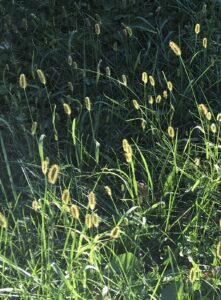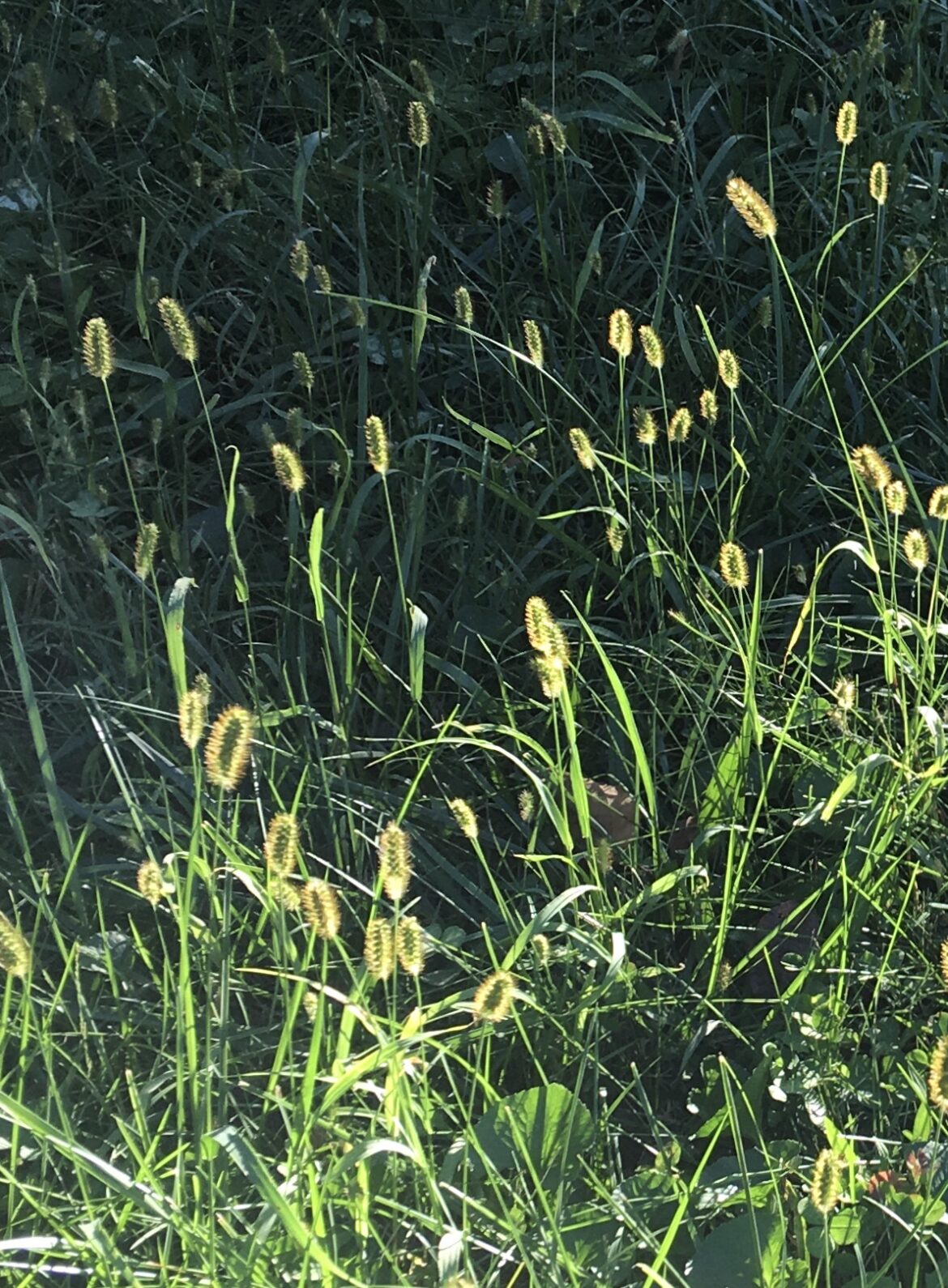September 17th
The 260th Day of the Year
See, Anarda, Fall is coming home,
bringing all its fruits.
Manuel de Navarrete
Sunrise/set: 6:18/6:41
Day’s Length: 12 hours 23 minutes
Average High/Low: 77/55
Average Temperature: 66
Record High: 92 – 1931
Record Low: 39 – 1959
The Daily Weather
Highs in the 80s come one year in four. Seventies occur 40 percent of the time, 60s twenty-five percent; and from now through the end of the month, the chance of highs just in the 50s remains steady at ten percent. This morning, for the first time in the fall, low temperatures fall into the 40s about half the time. Chances of rain: 35 percent.
Natural Calendar
In the third week of September, Wildflower Season lingers, but most of the major late-blooming plants gradually close their flowering cycle for the year. Light Frost Season gathers momentum. Katydid Season weakens in the cool nights, and Black Walnut, Buckeye, Cottonwood and Serviceberry Leaf-fall Seasons gradually close in town just as Winter Wheat and Barley Planting Seasons commence on the farm.
Daybook
1982: Mulberry and Osage begin to get yellow leaves. Small white asters are prominent in front of the house.
1983: Trumpet creepers still strong. Grackles in the back trees all afternoon. Fall raspberries (Fall Red variety) are still coming in, about a pint every few days.
1984: Grinnell Swamp: Touch-me-not pods come to their peak of popping. Nodding bur marigold (Bidens cernua) found. Lobelia still full. Zigzag goldenrod early bloom. White snakeroot still full. Boneset faded. Poplars yellowing, sycamore leaves browning at the edges. Black and gold striped caterpillar of the milkweed tiger moth identified.
1986: Many catalpas almost gone. The ash by my window has lost most of its leaves.
1987: Honeysuckle branches heavy with red berries. Farmers’ Market selling squash and late melons, mums, tomatoes, zucchini, gourds, apples, concord grapes, and the last peaches.
1988: Cardinal sings off and on all day.
1989: No cicadas this afternoon. Red berries on the spicebush. Bright New England asters seen today. Dozens of Helianthus tuberosus full bloom in a soybean field. A flock of geese has come to the field by Antioch again. No katydids last night, a few chanting tonight, one right on the front porch.
1990: Every event of fall adds to the momentum. The acts accumulate like leaves in the backwaters.
1991: Magnolia seeds are coming down, box elders shedding, small cottonwoods three-fourths gone, my ash tree almost all fallen.
1993: Still no asters blooming at home, only a few at South Glen. The drought has kept them back, as it has the mums. At the Covered Bridge, a cardinal sang once as I crossed over into the woods. Swamp bidens were in full bloom at the swamp, a few goldenrod and small white asters. Wingstem, protected by the canopy, was still bright. The river was as low as during the drought of five years ago, and it had a dank smell, a faint odor of sewage, the drought and the quiet air exposing the village’s pollution.
1995: This past week, the weather shifted into the cooler 70s, and the clear Sun that had dried out late August and early September was diluted with clouds and rain. At the park, the box elder is paler, rustier; the red maple’s scattered deterioration has increased to a few minor patches now. In the south garden, the sunflowers that sprouted from birdseed in late July are in full bloom. Along Limestone Street, black walnut trees are half bare.
1997: Virgin’s bower and tall violet sedum are still in full bloom around town. Yesterday, I saw a bed of August Moon hosta in full bloom. Last peaches coming in at the orchard. More jays this morning, but no cardinals or sparrows, no robin calls. Crickets strong. Katydids loud last night. Berries on the hawthorns outside my room are starting to turn red.
1998: Artichokes and goldenrod still full. Redbud, locust, yellow poplar, ash, sumac, buckeye all turning here and there.
1999: Five silver-spotted skippers working one pink sedum in the east garden.
2001: In the chilly 47-degree morning, crickets are quiet except for just a few that sing so slowly it seems they are whining, crying over the cold.
2003: The zinnias have been attacked by powdery mildew for the past few days, are beginning to lose their beauty. In the Women’s Park along Corey Street, almost all the coneflowers are black. Monarch and painted lady (Cynthia) butterflies continue to pass through the garden. My ash tree at Wilberforce has two huge splotches of gold. One Japanese beetle found on the roses. A few dead Asian lady beetles noticed on the roof.
2004: Virgin’s bower and New England asters are still at the height of their bloom, but their slow decay has begun. False boneset is about half gone.
2007: Virgin’s bower, New England asters and false boneset are still in full bloom. The Jerusalem artichoke flowers are just beginning to unfold. Another flock of starlings and a first flock of blackbirds seen in the countryside today. Nothing inside Yellow Springs, though. Walking through town tonight with Jean: we saw two milkweed pods that had opened early.
2010: Crows at 5:52 this morning. In the alley, robins peeping, starlings feeding and chattering. On Dayton Street, black walnuts cover the side of the street like mulberries. In the yard, the cardinal fledglings are feeding without their parents. Small white asters coming in at Peggy’s and in the alley.
2011: When I walked out the door this morning a little after 6:00, crows were calling, and a male and female cardinal were on the platform feeder. Some tree crickets in the early morning, then a growing chorus through the afternoon until the evening – although still cool – roused even Gerard’s katydids along Dayton Street. In the garden this afternoon, one tiger swallowtail, one Eastern black, one mourning cloak, one small fritillary, two buckeyes, a few silver-spotted skippers, many cabbage whites, no monarchs. At the northwest corner of the porch, the white autumn crocus that I had thought dead the other day suddenly rose to produce three giant blossoms. And in the alley, hidden at the back of Frank’s old house, a clump of violet crocus was blooming, too.
2012: Preoccupied with other things, I forgot to notice when the Danielsons’ Jerusalem artichokes came in to bloom – but they are full now.
2013: Crows at 6:10 this morning. On my walk with Bella, at 7:30, I could hear the steady distant chattering of starlings in the high trees, and along Limestone Street, the clucking of chickens behind honeysuckle bushes. The small-leafed hostas with violet flowers are still blooming in front of Don’s house and Judy’s. On the way to Wilmington, I saw the very first silage cutting, the first goldenrod rusting. On the way home: The whole sky was filled with magnificent wispy cirrus, and they stayed throughout the evening as the full moon was rising.
2014: Walked outside after lunch: one monarch, one painted lady (Cynthia) in the zinnias. My short visits to the garden often let me see what I am looking for. Under the giant beggartick plant, the white autumn crocus plant is coming into full bloom. At the corner of High and South West College Streets, the last prairie dock flower is blooming. Today Jonatha wrote: “I have seen three monarchs this year (so sad, only three), and all last Sunday. Two were on the flowers by Dayton YS Road, in front of the Little Free Library. The other was on the Glass Farm.”
2016: At the St. Clare Monastery, lush white snakeroot throughout the woods, and Jumpseeds common and jumping. Throughout the drive from Yellow Springs to Cincinnati, no leafturn noticed, the woods as green as in Deep Summer, one power line with blackbirds side by side for yards and yards. A blue jay was calling when I arrived home in the middle of the afternoon.
2017: Warm and bright sun: Two hummingbirds (one brilliant green), a monarch, a tattered great spangled fritillary and many cabbage whites in the zinnias. In the Caribbean, Hurricane Maria moves toward Puerto Rico. In the northeast Atlantic, Hurricane Jose travels north near the coast.
2019: Continued warm and dry. This morning at 6:40, one clear cardinal call, then silence except for the buzzing of the tree crickets. In the garden midmorning: only cabbage whites and fluttering hackberry leaves. In the afternoon, three hummingbirds and half a dozen cabbage whites. No monarchs seen today. The virgin’s bower, flower, climbs up into Janet’s redbud tree. In my yard, Moya’s and Judy’s, the large-leafed white blossomed hostas are ending their flowering seasons. The thin-leafed late hostas with violet flowers remain in full bloom, as in years past. Honeysuckle berryfall gains momentum. At Ellis Pond, two blue jays were calling continually and flying back and forth between two trees.
2020: A flock of geese, honking, flew over the house as I sat on the porch watching the sunlight break through the trees. Mild and bright today, one monarch late morning, one Eastern black swallowtail in the middle of the afternoon. I noticed powdery mildew on some of the zinnias for the first time this year. On the east end of the north garden, in front of the tall marigolds, the first New England asters bloomed. Before supper, Ranger and I walked the Covered Bridge habitat for the first time since last fall. In the field (solid with goldenrod), the New England asters were open. In the woods, wingstem was almost gone, the blue lobelias were down to a few blossoms per plant, zigzag goldenrod was full, wood nettle all gone to seed, its bare umbels like antlers reaching above the tattering undergrowth. Crows, hawks, blue jays occasionally on the other side of the tree line, far off. I looked closely at the river and the far shore, knowing it was the same river and shore I had first walked along over forty years ago. The water was low and clear, most of the stones at the bottom visible. My sensations were my feelings of nostalgia, familiarity, loss, home, gratitude, confusion, peace. The future seemed part of that landscape, too, unimaginable in the same way that the decades of memories were indistinguishable, the repetition of walks blurring the past, closing it pores, making the present so dense.
Sometimes hath the brightest day a cloud;
And after summer evermore succeeds
Barren winter, with his wrathful nipping cold:
So cares and joys abound as seasons fleet.
William Shakespeare


